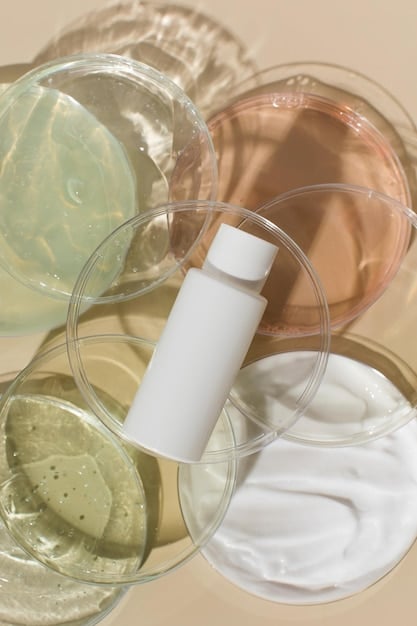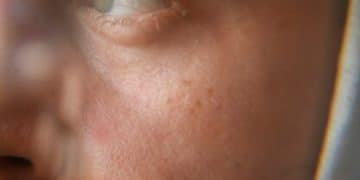The Latest in Anti-Aging: New Technologies in Men’s Skincare

The latest trends in men’s skincare showcase innovative anti-aging technologies, including personalized formulations, advanced light therapies, and microbiome-focused treatments.
The quest for youthful skin isn’t just for women anymore. Men are increasingly seeking effective solutions to combat the signs of aging. The latest in anti-aging: what new technologies are trending in men’s skincare? is a rapidly evolving field, with cutting-edge innovations offering promising results. This article explores the most exciting breakthroughs in men’s anti-aging skincare, helping you stay ahead of the curve and make informed choices for your skin.
Understanding the Science of Aging in Men
Before diving into the latest technologies, it’s essential to understand how skin aging differs in men. Men generally have thicker skin with more collagen and elastin, which means signs of aging may appear later but can be more pronounced once they emerge. Factors like shaving, sun exposure, and lifestyle choices also play significant roles.
Hormonal Influences on Male Skin
Testosterone significantly influences male skin, contributing to its thickness and oil production. As men age, testosterone levels decline, leading to reduced collagen synthesis and thinner skin. This hormonal shift often results in the appearance of wrinkles, sagging, and dryness.
External Factors Accelerating Aging
While genetics play a role, external factors can significantly accelerate skin aging. Prolonged sun exposure, without adequate protection, damages collagen and elastin fibers, leading to premature wrinkles and age spots. Similarly, smoking and excessive alcohol consumption can dehydrate the skin and impair its ability to repair itself.
- Sun Exposure: Consistent use of broad-spectrum sunscreen is crucial to prevent UV damage.
- Lifestyle Choices: Healthy diet, regular exercise, and adequate sleep promote skin health.
- Skincare Routine: Using targeted anti-aging products can address specific concerns like wrinkles and fine lines.

Understanding these factors allows men to adopt a proactive approach to skincare, combining healthy habits with advanced technologies to maintain youthful skin.
Peptides: The Powerhouse Ingredients
Peptides are short chains of amino acids, the building blocks of proteins, that play a crucial role in signaling the skin to produce more collagen. Incorporating peptides into your skincare routine can lead to firmer, smoother skin.
How Peptides Work
Peptides act as messengers, triggering specific responses in the skin. Different peptides target different concerns, such as collagen production, wrinkle reduction, and hydration. By stimulating collagen synthesis, peptides help improve skin elasticity and reduce the appearance of fine lines and wrinkles.
Matrixyl, for example, is a peptide known for its ability to stimulate collagen production and reduce wrinkle depth. Copper peptides, on the other hand, promote wound healing and collagen synthesis, improving overall skin texture.
When choosing peptide-based products, consider the specific peptide and its intended benefit. Look for serums, creams, and moisturizers that contain a blend of peptides to address multiple concerns simultaneously. Consistent use of these products can result in visibly younger-looking skin over time.
Benefits of Using Peptides
- Improved Collagen Production: Peptides stimulate collagen synthesis, improving skin elasticity and firmness.
- Reduced Wrinkles: Targeted peptides can reduce the appearance of fine lines and wrinkles.
- Enhanced Hydration: Some peptides help improve skin hydration and barrier function.
Peptides are a powerful addition to any anti-aging skincare routine, offering targeted solutions for various skin concerns. For the latest in anti-aging: what new technologies are trending in men’s skincare, peptides are definitely worth exploring.
Growth Factors: Stimulating Skin Regeneration
Growth factors are naturally occurring proteins that regulate cell growth and division. In skincare, they stimulate collagen production and promote skin regeneration, leading to a more youthful complexion.
The Role of Growth Factors in Skincare
Growth factors are like messengers that regulate cellular activities. They signal skin cells to produce more collagen, elastin, and hyaluronic acid which are essential for maintaining skin firmness, elasticity, and hydration. They also help repair damaged skin cells, reducing the appearance of scars, fine lines, and wrinkles.
EGF (Epidermal Growth Factor) is a commonly used growth factor in skincare products. It stimulates cell growth and division, promoting wound healing and collagen synthesis. TGF-beta (Transforming Growth Factor beta) is another growth factor that plays a role in collagen production and skin regeneration.
Growth factor-based products can be particularly beneficial for men looking to address signs of aging, such as wrinkles, age spots, and sagging skin. These products can help improve skin texture, tone, and overall radiance.
Incorporating Growth Factors into Your Routine
When selecting growth factor products, consider serums, creams, and moisturizers that contain a blend of growth factors to target multiple skin concerns. Apply these products after cleansing and toning, and before applying sunscreen during the day or richer moisturizers at night. Consistent use is essential to see noticeable improvements in skin texture and appearance.

Growth factors offer a promising avenue for men seeking effective anti-aging solutions. Growth factors signal the skin to behave like younger skin.
LED Therapy: Light Up Your Skin
LED (Light Emitting Diode) therapy involves exposing the skin to specific wavelengths of light to stimulate cellular activity. Different colors of light target different skin concerns, making it a versatile anti-aging treatment.
Understanding LED Light Therapy
LED therapy works by delivering specific wavelengths of light to the skin, which are absorbed by cells and converted into energy. This energy stimulates various cellular processes, such as collagen production, inflammation reduction, and acne control. Different colors of light have different effects on the skin.
Red light therapy stimulates collagen production, reduces inflammation, and improves circulation. Blue light therapy targets acne-causing bacteria, reducing breakouts and blemishes. Near-infrared (NIR) light penetrates deeper into the skin, promoting wound healing and reducing inflammation.
Benefits of LED Therapy for Men
- Collagen Production: Red light stimulates collagen synthesis, improving skin elasticity and firmness.
- Acne Control: Blue light targets acne-causing bacteria, reducing breakouts and blemishes.
- Inflammation Reduction: LED therapy reduces inflammation and promotes wound healing.
How to Use LED Therapy
LED therapy devices are available for home use, offering a convenient way to incorporate this treatment into your skincare routine. Follow the manufacturer’s instructions for optimal results. Typically, sessions last between 10 to 20 minutes, several times a week. You may start seeing results after a few weeks.
LED therapy can be a valuable addition to your anti-aging arsenal. In the latest in anti-aging: what new technologies are trending in men’s skincare?, LED therapy could be a game changer.
Microbiome Skincare: Nurturing Your Skin’s Ecosystem
The skin microbiome is a community of bacteria, fungi, and viruses that live on the skin’s surface. Maintaining a healthy microbiome is essential for skin health, and new skincare technologies focus on nurturing this ecosystem.
The Importance of a Balanced Microbiome
A balanced microbiome helps protect the skin from pathogens, regulates inflammation, and supports overall skin health. Disruptions in the microbiome can lead to various skin issues, such as acne, eczema, and premature aging.
Probiotic skincare products contain live microorganisms that help restore and maintain a healthy microbiome. Prebiotic ingredients, on the other hand, nourish the existing beneficial bacteria, supporting their growth and activity. Postbiotic ingredients are the byproducts of bacterial fermentation, such as peptides and hyaluronic acid, which offer additional skin benefits.
Incorporating Microbiome Skincare into Your Routine
Look for cleansers, serums, and moisturizers that contain probiotic, prebiotic, and postbiotic ingredients. Avoid harsh cleansers and exfoliants that can strip the skin of its natural oils and disrupt the microbiome. Instead, opt for gentle, pH-balanced products that support a healthy skin barrier.
Benefits of Microbiome Skincare
- Improved Skin Barrier: Microbiome skincare helps strengthen skin barrier, protecting it from external aggressors.
- Reduced Inflammation: A balanced microbiome helps regulate inflammation.
- Enhanced Hydration: Some probiotic ingredients help improve skin hydration.
By nurturing your skin’s ecosystem, you can improve its overall health and resilience, combating signs of aging and promoting a youthful complexion. Also, these solutions can be easily added to the latest in anti-aging: what new technologies are trending in men’s skincare?
The Future of Men’s Anti-Aging Skincare
The future of men’s anti-aging skincare holds exciting possibilities, with personalized formulations, advanced delivery systems, and innovative ingredients leading the way.
Personalized Skincare
With advancements in technology, personalized skincare is becoming more accessible. DNA testing and skin analysis tools can provide insights into your unique skin characteristics and needs, allowing for customized skincare routines and formulations. Products are then tailored to address specific concerns, optimizing results and promoting healthy, youthful skin.
Advanced Delivery Systems
Advanced delivery systems, such as liposomes and nanoparticles, enhance the penetration of active ingredients into the skin. These systems encapsulate active ingredients and transport them to deeper layers of the skin, where they can exert their effects more effectively. This approach offers improved potency and efficacy, maximizing the benefits of anti-aging skincare products.
Emergence of Innovative Ingredients
Researchers are continually exploring new ingredients and technologies to combat the signs of aging. Plant stem cells extract, marine-derived ingredients, and synthetic peptides show promise in stimulating collagen production, reducing inflammation, and promoting skin regeneration. The fusion of cutting-edge science with natural botanicals is paving the way for a new era of anti-aging skincare.
| Key Point | Brief Description |
|---|---|
| 💪 Peptide Power | Peptides stimulate collagen production, reducing wrinkles. |
| ✨ LED Therapy | Light therapy boosts collagen, reduces acne, and heals skin. |
| 🦠 Microbiome Balance | Balances skin’s bacteria for better barrier and hydration. |
| 🧪 Growth factors | Stimulates collagen and elastin production for skin regeneration. |
FAQ
Men’s skin is generally thicker and has more collagen, leading to later but more pronounced signs of aging. Hormonal factors, such as testosterone, also affect skin thickness and oil production differently.
Peptides act as messengers, signaling the skin to produce more collagen, which improves skin elasticity and reduces wrinkles. Different peptides target specific skin concerns, enhancing overall skin health.
Growth factors are proteins that regulate cell growth and division, stimulating collagen production and promoting skin regeneration. They help repair damaged skin cells, reducing signs of aging.
LED therapy uses specific wavelengths of light to stimulate cellular activity. Red light boosts collagen, blue light combats acne, and near-infrared light heals. Therapy reduces inflammation, giving skin a younger look.
A balanced microbiome protects the skin from pathogens, regulates inflammation, and supports overall skin health. Probiotic skincare products help restore and maintain this balance, combating signs of aging.
Conclusion
Embracing the advancements in anti-aging technologies can significantly improve the health and appearance of men’s skin. From peptides and growth factors to LED therapy and microbiome skincare, the latest in anti-aging: what new technologies are trending in men’s skincare? are offering targeted solutions for various skin concerns, helping men maintain a youthful complexion. Staying informed and adopting a proactive approach to skincare ensures long-term benefits.





